Paper Menu >>
Journal Menu >>
 Journal of Modern Physics, 2013, 4, 923-929 http://dx.doi.org/10.4236/jmp.2013.47124 Published Online July 2013 (http://www.scirp.org/journal/jmp) Information Soliton Qiao Bi1, Kongzhi Song2 1Department of Physical Science and Technology, Science School, Wuhan University of Technology, Wuhan, China 2Institute of Space Medico-Engineering, Beijing, China Email: *************** Received April 24, 2013; revised May 26, 2013; accepted June 22, 2013 Copyright © 2013 Qiao Bi, Kongzhi Song. This is an open access article distributed under the Creative Commons Attribution Li- cense, which permits unrestricted use, distribution, and reproduction in any medium, provided the original work is properly cited. ABSTRACT In this work, for u nderstanding bio-information transmission through long distance a type of nonlinear master equation is studied. We found that the nonlinear power term can introduce a novel solution of the equation, in which a possible invariant structure as an information so liton can exist when time elapses long enough. This provid es a sort of construc- tive channel for bio-info rmation tr ansmission for long distance. Keywords: Quantum Information; Coherent State; Nonlinear Kinetic Equation 1. Introduction Quantum information theory in treating interact trans- mission and processing of quantum states, entanglement of states for quantum computation, quantum cypoto- graphy or quantum teleportation has achieved great pro- gresses nowadays [1-6]. However, until recently it is clear what is fundamental dynamical equation directly re- lated to quantum information density (QID). In previous works [7,8] we have pr esented that the Liouville equation, the Schwinger-Tomonaga equation and the Einstein equ- ation still hold for quantum information density (QID): HI, I i t . Here I corresponding to a sort of general QID, especially, lnI is de- fined as QID. In this way, the definition I can be considered as a minimum unit of QID [9-15]. More- over, in the classical system, the similar Liouville equ- ation for the information density can also be established, which means this information representation is universal both for quantum and classical systems [7]. All of these dynamic formulations reveal an essential information character of universe. Then a question is raised: how a subject builds an efficient information channel to com- municate with any object or even universe by a long distance against decoherence or energy decaying? The background of this interesting question is that quantum communication needs to develop more stable and low dissipative channel to transmit or receive quan- tum singles against decoherence. This is, of cause, an ob- viously application for our model, however, in this work, we stress a mechanism for understanding the transmis- sion of bio-information through long distance in the So- matic experiments. This problem is important because started from 1987, the series of remote sensing thinking transmissions have been done by Shao Laisheng, Yu Huihua, Shen, J. Wang Boyang, Sheng Zujia, and Fang Lin Hu in Fudan University, China [16]. They made more than 3 years of experiments to find that the thinking sensing distance can reach more than 1000 km, and the sensing information can be numbers, text, graphics with colors. During 1987 to 1988, they had accomplished 37 times thinking sensing experiments, complete success was 14 times and partial success was 15 times, so the successful results were accounting for 41%. The sending information as random combination of 6 digital color pen written can be marked by the receiver as the number and color correctly. Close the time thinking, sensing in a few seconds to a few minutes. In 1990 they made remote sensing experiment of thinking between Beijing and Shanghai, sensing content of numbers and words, time difference from an hour to several hours or even more than ten hours. For the 15 experiments of Shanghai to Beijing in November 17-18, 1990, there existed succeed 8 times and 7 times of failures. In 1990 the experiments from Beijing to Shanghai, there were 8 times thinking sensing experiments, four of them were successful and four times were fail. Sensing successful contents were such as: Hua headmaster: Hello, spiced beans king, 98647, Spring in society. Time differences respectively C opyright © 2013 SciRes. JMP 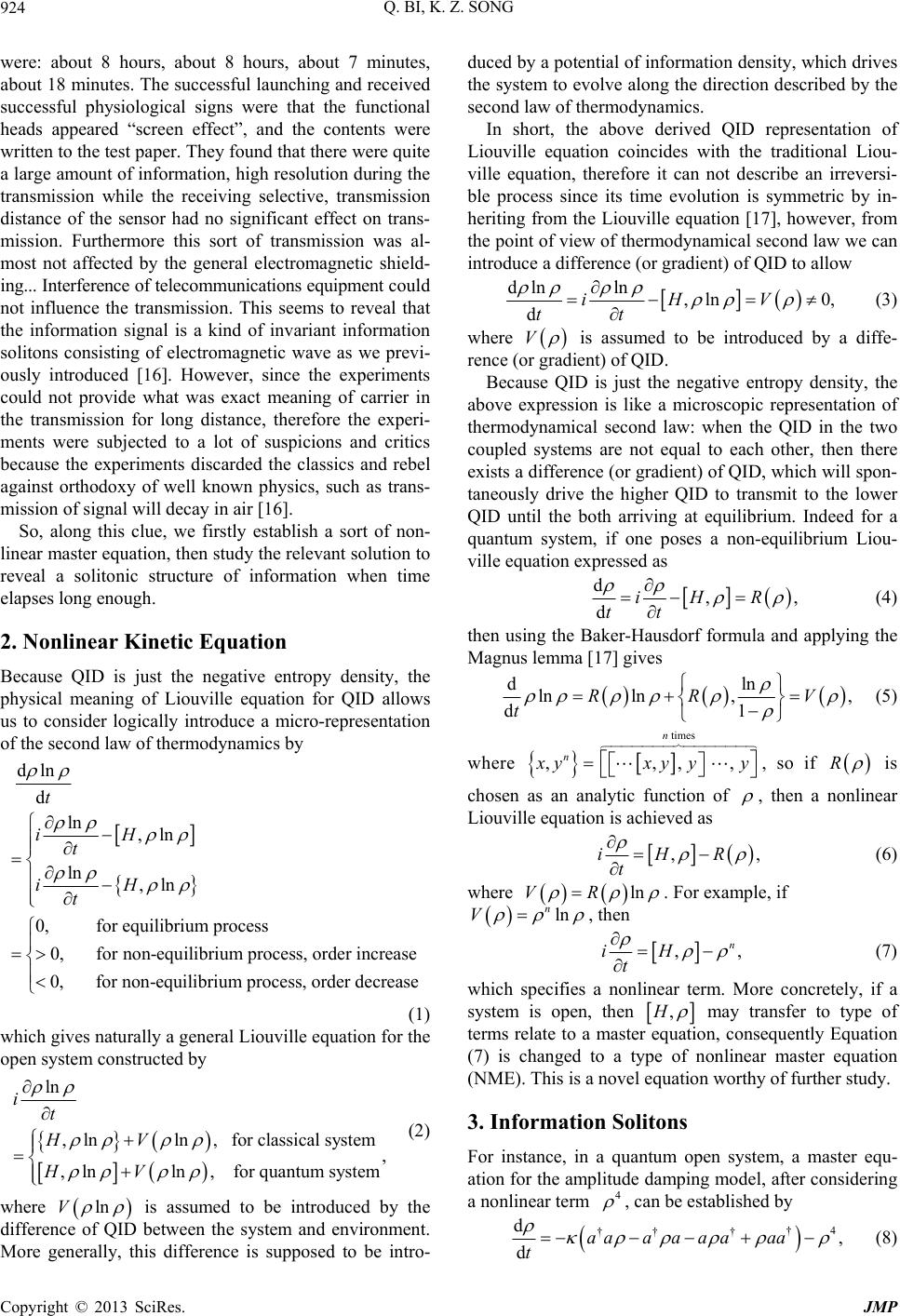 Q. BI, K. Z. SONG 924 were: about 8 hours, about 8 hours, about 7 minutes, about 18 minutes. The successful launching and received successful physiological signs were that the functional heads appeared “screen effect”, and the contents were written to the test paper. They found that there were quite a large amount of information, high resolution during the transmission while the receiving selective, transmission distance of the sensor had no significant effect on trans- mission. Furthermore this sort of transmission was al- most not affected by the general electromagnetic shield- ing... Interference of telecommunications equipment co ul d not influence the transmission. This seems to reveal that the information signal is a kind of invariant information solitons consisting of electromagnetic wave as we previ- ously introduced [16]. However, since the experiments could not provide what was exact meaning of carrier in the transmission for long distance, therefore the experi- ments were subjected to a lot of suspicions and critics because the experiments discarded the classics and rebel against orthodoxy of well known physics, such as trans- mission of signal will decay in air [16]. So, along this clue, we firstly establish a sort of non- linear master equation, then stud y the relevant solution to reveal a solitonic structure of information when time elapses long enough. 2. Nonlinear Kinetic Equation Because QID is just the negative entropy density, the physical meaning of Liouville equation for QID allows us to consider logically introduce a micro-representation of the second law of thermodynamics by dln d ln ,ln ln ,ln 0,for equilibrium process 0,fornon-equilibrium process, order 0,for non-equilibrium process, o t iH t iH t increase rder decrease (1) which gives naturally a general Liouv ille equatio n for the open syst em constructed by ln ,lnln, for class ,lnln, for quant it HV HV ical system, um system lnV (2) where is assumed to be introduced by the difference of QID between the system and environment. More generally, this difference is supposed to be intro- duced by a potential of information density, which drives the system to evolve along the direction described by the second law of thermodynamics. In short, the above derived QID representation of Liouville equation coincides with the traditional Liou- ville equation, therefore it can not describe an irreversi- ble process since its time evolution is symmetric by in- heriting from the Liouville equation [17], however, from the point of view of thermodynamical second law we can introduce a difference (or gradient) of QID to allow dlnln ,ln 0, diHV tt (3) V where is assumed to be introduced by a diffe- rence (or gradient) of QID. Because QID is just the negative entropy density, the above expression is like a microscopic representation of thermodynamical second law: when the QID in the two coupled systems are not equal to each other, then there exists a difference (or gr adient) of QID, wh ich will spon- taneously drive the higher QID to transmit to the lower QID until the both arriving at equilibrium. Indeed for a quantum system, if one poses a non-equilibrium Liou- ville equation expressed as d,, diHR tt (4) then using the Baker-Hausdorf formula and applying the Magnus lemma [17] gives dln ln ln,, d1 RR V t times ,,,, n n (5) where x yxyyy , so if R is chosen as an analytic function of , then a nonlinear Liouville equation is achieved as ,,iHR t (6) lnVR where . For example, if ln n V , then ,, n iH t (7) which specifies a nonlinear term. More concretely, if a system is open, then ,H may transfer to type of terms relate to a master equation, consequently Equation (7) is changed to a type of nonlinear master equation (NME). This is a novel equation worthy of further study. 3. Information Solitons For instance, in a quantum open system, a master equ- ation for the amplitude damping model, after considering a nonlinear term 4 , can be established by ††††4 d, daaaaa aaa t (8) Copyright © 2013 SciRes. JMP 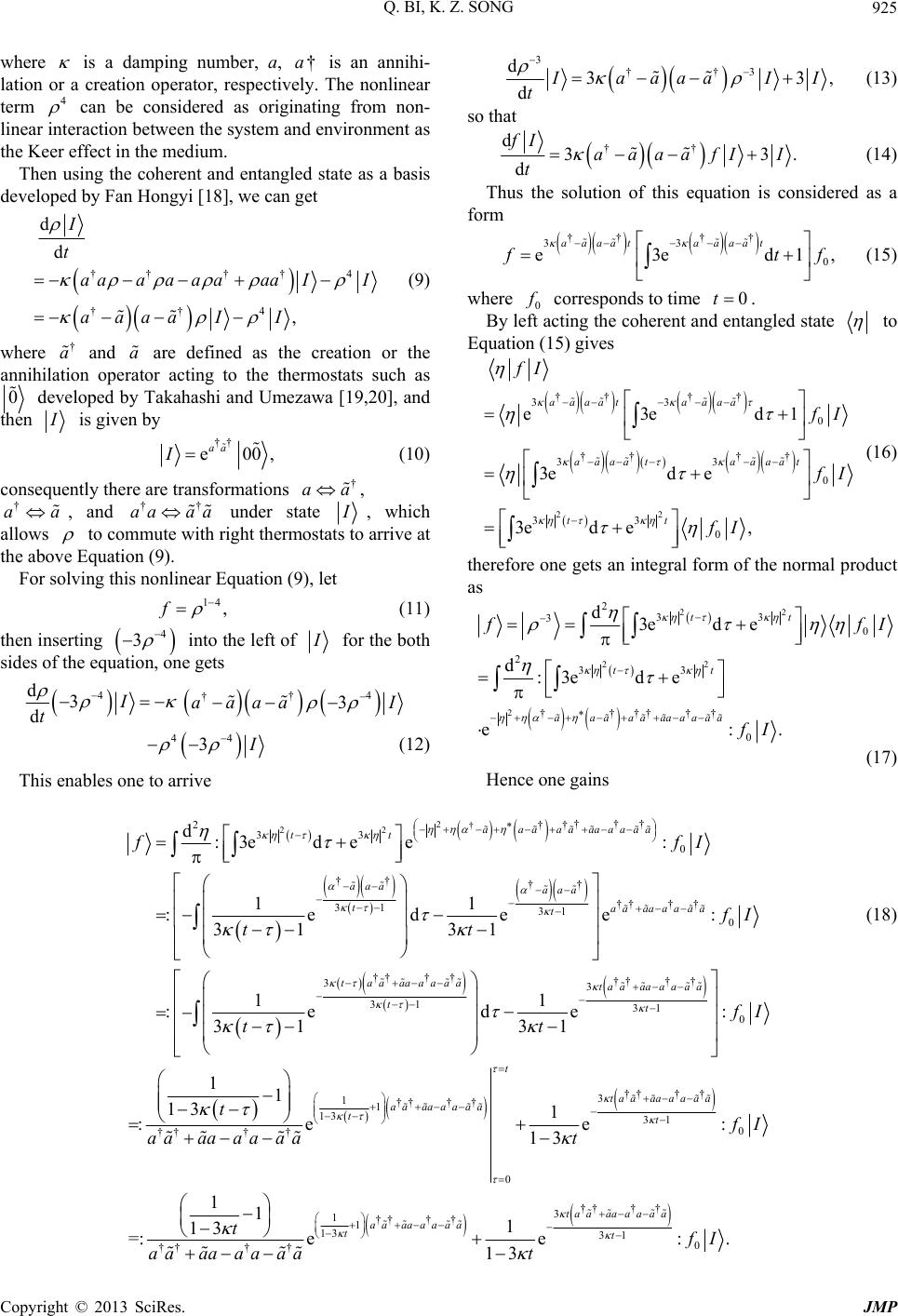 Q. BI, K. Z. SONG JMP 925 where is a dampiber, a, †a is an lation or a creation oprespectively. The no 4 ng num erator, annihi- nlinear Copyright © 2013 SciRes. term can be considered as origiing from non- linear interaction between the system and environment as the Keer effect in the medium. Then using the coherent and entangled state as a basis developed by Fan H ongyi [18 ], we can get nat †† † †† † 4 4 , aa aaa aaaII a aaaII (9) e † a and a are defined as the creation or the lation operator acting to the thermostats such as d d I t wher annihi 0 deoped by Takahashi and Umezawa [19,20], and then vel I is given by †† e00, aa I (10) consequently there are transformations † aa, †† aa aa r † aa, and unde state I , which allows to commute with right therm the Equatio For sing this nonlinear Equation (9), let 14 f ostats to arrive at e abovn (9). olv , (11) then inserting 4 3 into the left of I for the both e equation, onesides of th gets 4 d3 dI t ††4 3a aaaI 44 3 I () This enables one to arrive 12 3††3 d33, d I aaaaI I t (13) so that †† d33. d fI aaaafII t (14) Thus the solution of this equation is considered as a form †††† 33 0 e3ed1, aaaat aaaat ftf f0t (15) where corresponds to time . 0 By left acting the coherent and entangled state to Equation (15) gives 22 †††† 33 0 †††† 33 0 33 0 e3ed1 3ed e 3ed e, aaaat aaaa aaaataaaat tt fI f I f I fI (16) therefore one gets an integral form of the normal product as 22 22 2 233 30 233 ††††† † 0 d3ed e d:3ed e e:. tt tt aaaaa aaaaaa f fI fI (17) Hence one gains 2† 22 ††††† 33 0 †† †† †† † † 31 31 0 3 edee: 11 :edee: 31 31 1 :e 31 aaaaaaaaaaa tt aaa aaa taa aaaaaa t t fI 2 d:3f f I tt t ††† ††† †† 3 31 31 0 1 de : 31 aa aaaaaataaaaaa aa tt f I t (18) †††† 3 1†††† 1 13 31 0 † 0 1†††† 1 13 † 1 13 1 :e e: 13 111 13 =: ee 13 t taaaa aa aa aa aaaaaa tt aa aaaaaa t t1 f ††† †† † I t aaaa aa aa t t aaaa aa aa ††† † 3 31 0 :. taaaa aa aa tfI 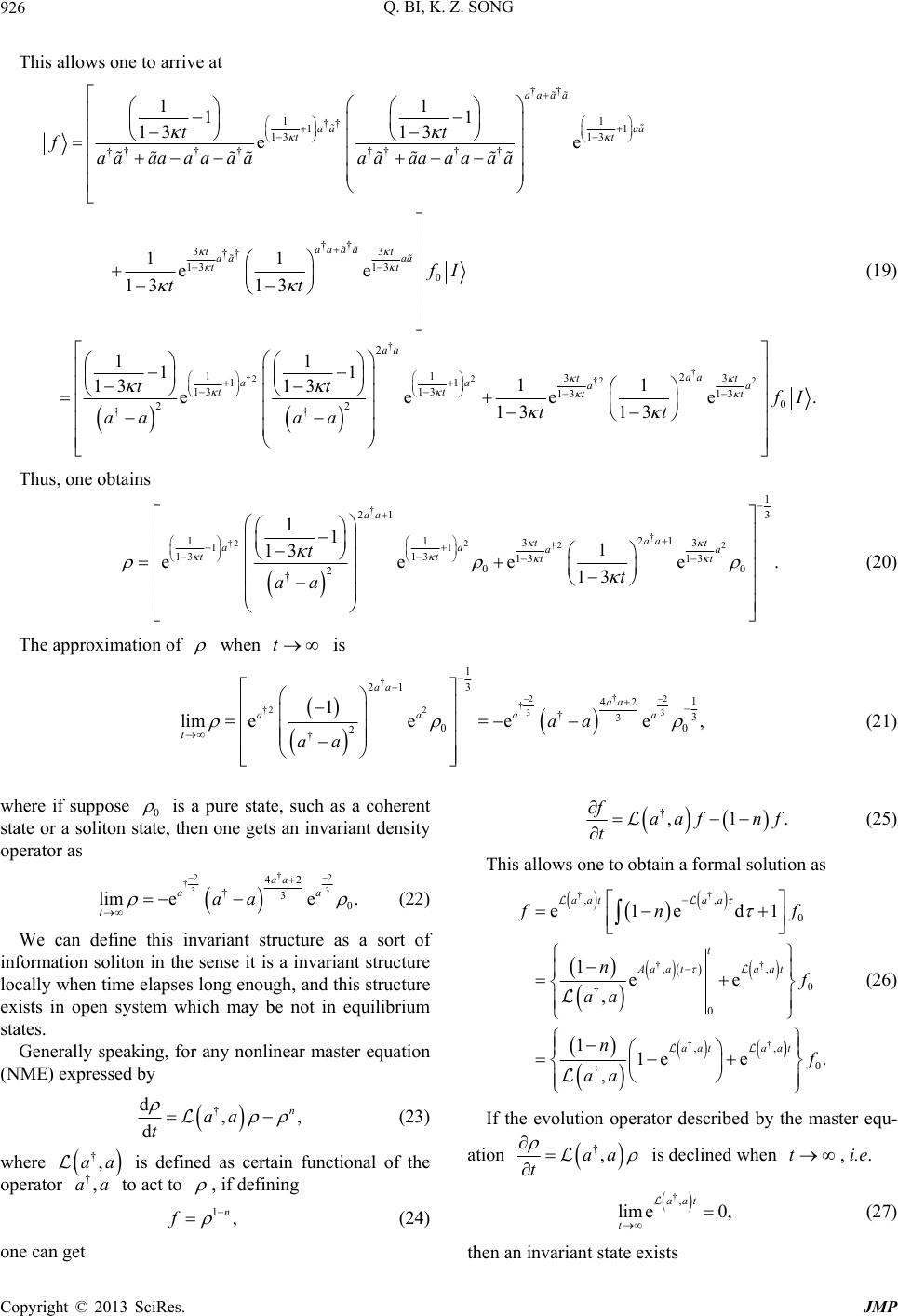 Q. BI, K. Z. SONG 926 This allows one to arrive at †† 11 †† 11 13 13 †††††††† ††3 †13 11 11 13 13 ee 1 e 13 13 aa aa aa aa tt aa aat aa t tt faaaa aaaaaaaa aaaa tt 3 † 13 1 e t aa t † † †22 †2 2 0 2 11 2 33 11 1313 1313 0 22 †† 11 11 11 13 13 eeee. 13 13 aa aa tt aa aa tt tt fI tt f I tt aa aa (19) Thus, one obtains † † †22 †2 21 11 21 11 13 13 13 2 † 111 13 eee 13 aa aa aa tt t t aa 2 1 3 33 13 00 e. tt aa tt (20) The appration oximof when t is † † †2 2 1 3 21 † 2 † 1 lim eee aa aaa taa aa † 22 33 1 42 3 3 00 e , aa a (21) whe suppose 0 re if is a pure state, such as a coherent state or a soliton state, then one gets an invariant density op †,1. faaf nf t (25) This allows one to obtain a formal solution as erator as † 22 33 42 30 e . aa aa †† lim e taa (22) We can define this invariant structure as a sort of information soliton in the sense it is a invariant structure cally when time elapses long enough, and this structur e tem peaking, for any nonlinear master equation (NME) expressed by lo exists in open sys which may be not in equilibrium states. Generally s †,, n aa d dt (23) where †,aa is defined as certain functional of the operator †,aa to act to , if defining 1, n f (24) one can get †† †† †† ,, ,, 0 † ,, † e1e 1ee 1e e , aat aa t Aa ata at aat aat 0 d1 0 , 1 0. f nf n f aa n f aa (26) evolutio If then operator described by the master equ- ation †,aa t is when declined t , i.e. †, lime 0, aat t (27) then an invariant state exists Copyright © 2013 SciRes. JMP 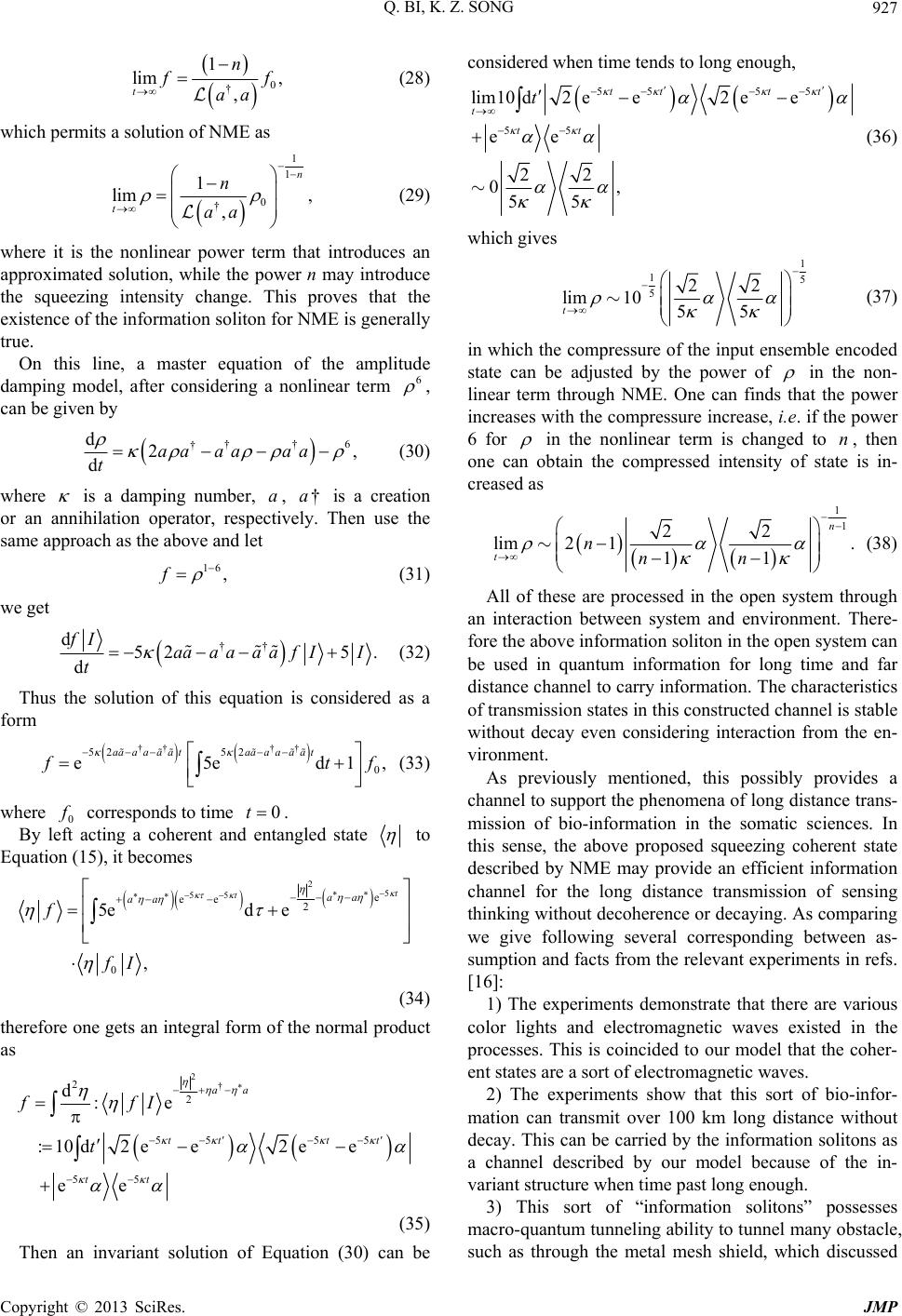 Q. BI, K. Z. SONG 927 0 † 1, , n lim t f f aa w (28) hich permits a solution of NME as 1 1 0 †, , n n aa (29) where it is the nonlinear power term that introdu approximated solution, while the power n may introduce the squeezing intensity change. This proves that the existence of the information soliton for NME is generally true. da 1 lim t ces an On this line, a master equation of the amplitude mping model, after considering a nonlinear term 6 , can be give n b y †6 2,aa †† d daa aa t (30) ber, a, †a is a creation respectively. Then use the same approach as the above and let 16 ,f (31) where is a damping num or an annihilation operator, we get †† d52 d fI aa aa aa t 5. f II (32) Thus the solution of this equation is considered as a form †††† 52 52 0 e5ed1, aaaa aataaaa aat f tf (33) where 0 f correso time 0t. ponds t By left acting a coherent and entangled state to Equation (15), it becomes 2 55 ee 25 e 5ed et taa aa f f the normal product as 0, fI (34) therefore one gets an integral form o 2† 22 55 55 d:e :10d2e e2e e aa tt t ffI t 55 ee tt t (35) Then an invariant solution of Equation (30) can be considered when time tends to long enough, 55 55 lim10d2 ee2 ee 0, 55 tt tt t 55 t tt ee 22 ( which gi ve s 36) 1 15 522 lim10 55 t ( e can be adjusted by the power of 37) in which the co mpressure of the input ensemble encoded stat in the non- linear term through NME. One can finds that the power increases with the compressure increase, i.e. if the power 6 for in the nonlinear term is changed to n, then one can obtain the compressed intensity of state is in- creased as 1 1 22 lim2 1. n n 11 tnn All of these are processed in the open sys tem through an interaction between system and environment. There- fore the above information soliton in the open system can be used in quantum information for long time a distance channel to carry information. The characteristics of transmission states in this constructed channel is stable without decay even considering interaction from the en- usly mentioned, this possibly provides a channel to su pport the phenomena of long distance trans- mission of bio-information in the somatic this sense, the above proposed squeezing coherent state o n riments demonstrate that there are various color lights and electromagnetic waves existed in the processes. This is coincided to our model that the coher- ent states are a sort of electromagnetic waves. 2) The experiments show that this sort of bio-infor- m (38) nd far vironment. As previo sciences. In described by NME may provide an efficient information channel for the long distance transmissin of sensing thinking without decoherence or decaying. As comparing we give following several corresponding between as- sumptio and facts from the relevant experiments in refs. [16]: 1) The expe ation can transmit over 100 km long distance without decay. This can be carried by the information solitons as a channel described by our model because of the in- variant structure when time past long enough. 3) This sort of “information solitons” possesses macro-quantum tunneling ability to tunnel many obstacle, such as through the metal mesh shield, which discussed Copyright © 2013 SciRes. JMP 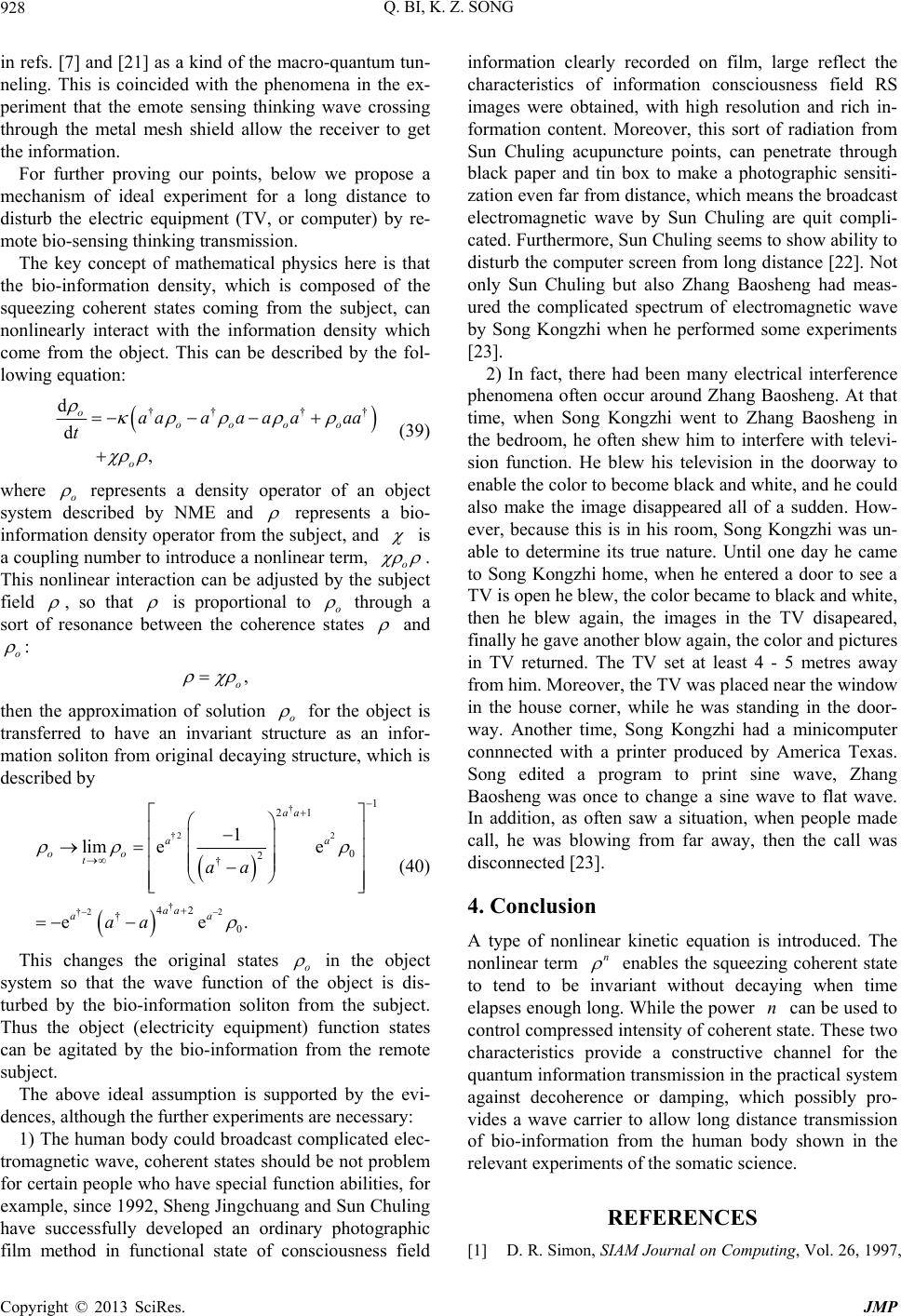 Q. BI, K. Z. SONG 928 in refs. [7] and [21] as a kind of the macro-quantum tun- neling. This is coincided with the phenomena in the ex- pe ing coherent states coming from the subject, can no riment that the emote sensing thinking wave crossing through the metal mesh shield allow the receiver to get the information. For further proving our points, below we propose a mechanism of ideal experiment for a long distance to disturb the electric equipment (TV, or computer) by re- mote bio-sensing thinking transmission. The key concept of mathematical physics here is that the bio-information density, which is composed of the squeez nlinearly interact with the information density which come from the object. This can be described by the fol- lowing equation: †† †† d, ooooo o aaaa aaaa t (39) where o d represents a density operator of an object system described by NME and represents a bio- information density operator from the subject, and is a coupling number to introduce a nonlin ear term, o . This nonlinear interaction can be adjusted by the subject field , so that is proportional to o through a sort of resonance between the coherence states and o : , o then the approximation of solution o for the object is transferred to have an invariant structure as an infor- mation soliton from original decaying structure, which is described by † †2 2 † †2 2 1 21 0 2 † 42 † 1 lim ee e aa aa oo t aa a aa a 0 e . a a (40) This changesstates o the original in the system so that the wav function of the object turbed by the bio-information soliton from the subject. e i e ev hp o example, since 1992, Sheng Jingcng and Sun Chuling have successfully developed an ordinary photographic co btained, with high resolution and rich in- formation content. Moreover, this sort of radiation from Sun Chuling acupuncture points, can penetrate through black paper and tin box to make a photographic sensiti- zation even far from distance, which means the br electromagnetic wave by Sun Chuling are quit compli- cated. Furthermore, Sun Chuling seems to show ability to disturb the computer screen from long distance [22]. Not on sh object is dis- e Thus thobject (electricity equipment) function states can be agitated by the bio-informaton from the remote subject. The above ideal assumption is supported by thi- dences, although the further experiments are necessary: 1) Te human body could broadcast comlicated elec- tromagnetic wave, coherent states should be not prblem for certain people who have special fu nction abilities, for hua film method in functional state of nsciousness field information clearly recorded on film, large reflect the characteristics of information consciousness field RS images were o oadcast ly Sun Chuling but also Zhang Baoeng had meas- ured the complicated spectrum of electromagnetic wave by Song Kongzhi when he performed some experiments [23]. 2) In fact, there had been many electrical interference phenomena often occur around Zhang Baosheng. At that time, when Song Kongzhi went to Zhang Baosheng in the bedroom, he often shew him to interfere with televi- sion function. He blew his television in the doorway to enable the color to become black and white, and he could also make the image disappeared all of a sudden. How- ever, because this is in his room, Song Kongzhi was un- able to determine its true nature. Until one day he came to Song Kongzhi home, when he entered a door to see a TV is open he blew, the color became to black and white, then he blew again, the images in the TV disapeared, finally he gave another blow again, the color and pictures in TV returned. The TV set at least 4 - 5 metres away from him. Moreover, the TV was placed near the window in the house corner, while he was standing in the door- way. Another time, Song Kongzhi had a minicomputer connnected with a printer produced by America Texas. Song edited a program to print sine wave, Zhang Baosheng was once to change a sine wave to flat wave. In addition, as often saw a situation, when people made call, he was blowing from far away, then the call was disconnected [23]. 4. Conclusion A type of nonlinear kinetic equation is introduced. The nonlinear term n enables the squeezing coherent state to tend to be invariant without decaying when time elapses enough long. While the power n can be used to control compressed intensity of coherent state. These two characteristics provide a constructive channel for the quantum information transmission in the practical system against decoherence or damping, which possibly pro- vides a wave carrier to allow long distance transmission of bio-information from the human body shown in the relevant experiments of the somatic science. REFERENCES [1] D. R. Simon, SIAM Journal on Computing, Vol. 26, 1997, Copyright © 2013 SciRes. JMP 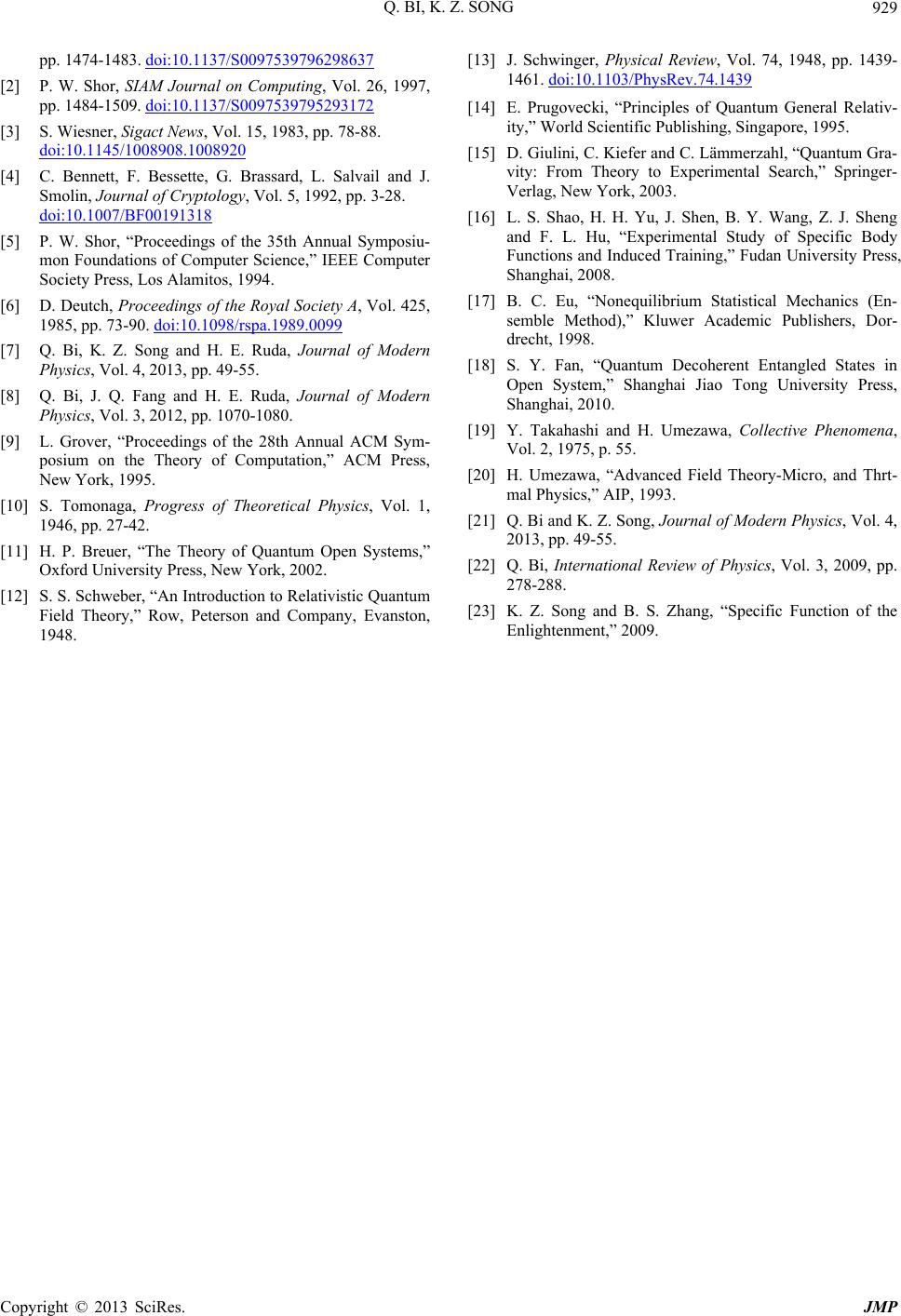 Q. BI, K. Z. SONG Copyright © 2013 SciRes. JMP 929 pp. 1474-1483. doi:10.1137/S0097539796298637 [2] P. W. Shor, SIAM Journal on Computing, Vol. 26, 1997, pp. 1484-1509. doi:10.1137/S0097539795293172 [3] S. Wiesner, Sigact News, Vol. 15, 1983, pp. 78-88. doi:10.1145/1008908.1008920 [4] C. Bennett, F. Bessette, G. Brassard, L. Salvail and J. Smolin, Journal of Cryptology, Vol. 5, 1992, pp. 3-28. doi:10.1007/BF00191318 roceedings of the 35th Annual Symposiu-[5] P. W. Shor, “P mon Foundations of Computer Science,” IEEE Computer Society Press, Los Alamitos, 1994. [6] D. Deutch, Proceedings of the Royal Society A, Vol. 425, 1985, pp. 73-90. doi:10.1098/rspa.1989.0099 [7] Q. Bi, K. Z. Song and H. E. Ruda, Journal of Modern Physics, Vol. 4, 2013, pp. 49-55. [8] Q. Bi, J. Q. Fang and H. E. Ruda, Journal of Modern Physics, Vol. 3, 2012, pp. 1070-1080. [9] L. Grover, “Proceedings of the 28th Annual ACM Sym- posium on the Theory of Computation,” ACM Press, New York, 1995. [10] S. Tomonaga, Progress of Theoretical Physics, Vol. 1 1946, pp. 27-42. [11] H. P. Breuer, m Open Syst , “The Theory of Quantuems,” Oxford University Press, New York, 2002. [12] S. S. Schweber, “An Introduction to Relativistic Quantum Field Theory,” Row, Peterson and Company, Evanston, 1948. [13] J. Schwinger, Physical Review, Vol. 74, 1948, pp. 1439- 1461. doi:10.1103/PhysRev.74.1439 [14] E. Prugovecki, “Principles of Quantum General Relativ- ity,” World Scientific Publishing, Singapore, 1995. [15] D. Giulini, C. Kiefer and C. Lämmerzahl, “Quantum Gra- , 2003. pecific Body Eu, “Nonequilibrium Statistical Mechanics (En- d B. S. Zhang, “Specific Function of the vity: From Theory to Experimental Search,” Springer- Verlag, New York [16] L. S. Shao, H. H. Yu, J. Shen, B. Y. Wang, Z. J. Sheng and F. L. Hu, “Experimental Study of S Functions and Induced Training,” Fudan University Press, Shanghai, 2008. [17] B. C. semble Method),” Kluwer Academic Publishers, Dor- drecht, 1998. [18] S. Y. Fan, “Quantum Decoherent Entangled States in Open System,” Shanghai Jiao Tong University Press, Shanghai, 2010. [19] Y. Takahashi and H. Umezawa, Collective Phenomena, Vol. 2, 1975, p. 55. [20] H. Umezawa, “Advanced Field Theory-Micro, and Thrt- mal Physics,” AIP, 1993. [21] Q. Bi and K. Z. Song, Journal of Modern Physics, Vol. 4, 2013, pp. 49-55. [22] Q. Bi, International Review of Physics, Vol. 3, 2009, pp. 278-288. [23] K. Z. Song an Enlightenment,” 2009. |

